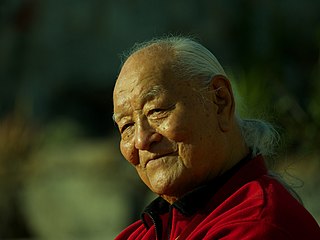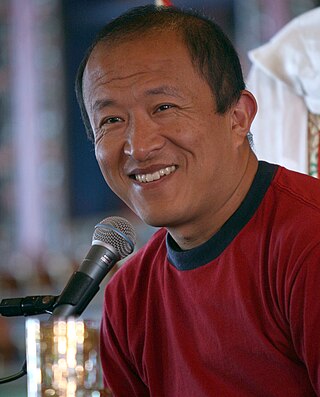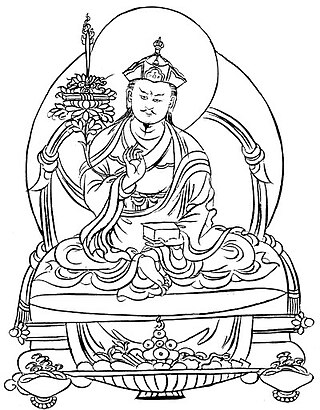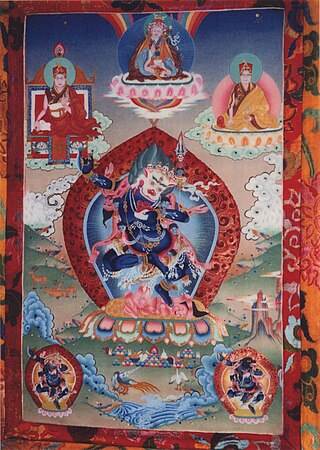A tulku is a distinctive and significant aspect of Tibetan Buddhism, embodying the concept of enlightened beings taking corporeal forms to continue the lineage of specific teachings. The term "tulku" has its origins in the Tibetan word "sprul sku", which originally referred to an emperor or ruler taking human form on Earth, signifying a divine incarnation. Over time, this term evolved within Tibetan Buddhism to denote the corporeal existence of highly accomplished Buddhist masters whose purpose is to ensure the preservation and transmission of a particular lineage.

Tashi Paljor, Dilgo Khyentse Rinpoche was a Vajrayana master, scholar, poet, teacher, and recognized by Buddhists as one of the greatest realized masters. Head of the Nyingma school of Tibetan Buddhism from 1988 to 1991, he is also considered an eminent proponent of the Rime tradition.

The Rimé movement is a movement or tendency in Tibetan Buddhism which promotes non-sectarianism and universalism. Teachers from all branches of Tibetan Buddhism – Sakya, Kagyu, Nyingma, Jonang, Gelug, and Bon – have been involved in the promoting Rimé ideals.

Nyingma, often referred to as Ngangyur, is the oldest of the four major schools of Tibetan Buddhism. The Nyingma school is founded on the first lineages and translations of Buddhist scriptures from Sanskrit into Tibetan in the eighth century, during the reign of King Trisong Detsen.

Jamyang Khyentse Wangpo, also known by his tertön title, Pema Ösel Dongak Lingpa, was a teacher, scholar and tertön of 19th-century Tibet. He was a leading figure in the Rimé movement.

Namkhai Norbu was a Tibetan Buddhist master of Dzogchen and a professor of Tibetan and Mongolian language and literature at Naples Eastern University. He was a leading authority on Tibetan culture, particularly in the fields of history, literature, traditional religions, and Traditional Tibetan medicine, having written numerous books and scholarly articles on these subjects.

Dzongsar Jamyang Khyentse Rinpoche, also known as Khyentse Norbu, is a Tibetan/Bhutanese lama, filmmaker, and writer. His five major films are The Cup (1999), Travellers and Magicians (2003), Vara: A Blessing (2013), Hema Hema: Sing Me a Song While I Wait (2017), and Looking for a Lady with Fangs and a Moustache (2019). He is the author of What Makes You Not a Buddhist (2007) and many other non-fiction works about Tibetan Buddhism.

Chokgyur Lingpa or Chokgyur Dechen Lingpa (1829-1870) was a tertön or "treasure revealer" and contemporary of Jamyang Khyentse Wangpo and Jamgon Kongtrul. Regarded as one of the major tertöns in Tibetan history, his termas are widely practiced by both the Kagyu and Nyingma schools.
Chokgyur Lingpa was the "manifestation," meaning the reincarnation, of King Trisong Deutsen's son, Prince Damdzin. Another of his former lives was the great terton, Sangye Lingpa, who revealed the Lama Gongdu. Chokgyur Lingpa was the last of the 100 major tertons. He was the owner of seven transmissions and is regarded as the universal monarch of all tertons. One of the reasons for this is that no other terton has revealed a teaching that includes the Space Section (Longdé) of Dzogchen. There are several Mind Section (Semde) revelations and all major tertons have revealed the Instruction Section (Mengagde), but only Chokgyur Lingpa transmitted the Space Section. This is why the Dzogchen Desum is considered the most extraordinary terma that he ever revealed. Chokgyur Lingpa's main consort was Dechen Chodron and Padmasambhava predicted that his three children would be emanations of the three family lords: Avalokiteshvara, Manjushri and Vajrapani. I don't like saying this, for it may sound like I'm bragging about my family line, but such a prophecy does exist. The Manjushri emanation was supposed to be Wangchok Dorje, the Avalokiteshvara emanation Tsewang Norbu and the Vajrapani emanation my grandmother, Konchok Paldron.

Dzongsar Khyentse Chökyi Lodrö was a Tibetan lama, a master of many lineages, and a teacher of many of the major figures in 20th-century Tibetan Buddhism. Though he died in 1959 in Sikkim, and is not so well known in the West; he was a major proponent of the Rimé movement within Tibetan Buddhism, and had a profound influence on many of the Tibetan lamas teaching today.
Tertön is a term within Tibetan Buddhism meaning a person who is a discoverer of ancient hidden texts or terma. Many tertöns are considered to be incarnations of the twenty five main disciples of Padmasambhava, who foresaw a dark time in Tibet. He and his consort Yeshe Tsogyal hid teachings to be found in the future to benefit beings. A vast system of transmission lineages developed. Scriptures from the Nyingma school were updated by terma discoveries, and terma teachings have guided many Tibetan Bon and Buddhist practitioners.

Sogyal Rinpoche was a Tibetan Dzogchen lama. He was recognized as the incarnation of a Tibetan master and visionary saint of the 19th century, Tertön Sogyal Lerab Lingpa. Sogyal Rinpoche was the founder and former spiritual director of Rigpa — an international network of over 100 Buddhist centres and groups in 23 countries around the world — and the author of the best-selling book The Tibetan Book of Living and Dying, which has been printed in 30 languages and 56 countries. Before his retirement, in the wake of abuse allegations in 2017, he had been teaching for 40 years in Europe, America, Asia and Australia.

Dzogchen Monastery is one of the "Six Mother Monasteries" of the Nyingma tradition of Tibetan Buddhism. It is located in Kham within modern day Dêgê County, Garzê Tibetan Autonomous Prefecture, Sichuan, China.

Kyabje Dudjom Jigdral Yeshe Dorje was known as Terchen Drodül Lingpa and as Dudjom Rinpoche. He is considered by many Tibetan Buddhists to be from a line of important Tulku lineage, and a renowned Tertön. Per lineage, he was a direct incarnation of both Padmasambhava and Dudjom Lingpa (1835–1904). He was a Nyingma householder, yogi, and a Vajrayana and Dzogchen master. According to his disciple Khenpo Tsewang Dongyal, he was revered as "His Holiness" and as a "Master of Masters".

Ayu Khandro, also known as Dorje Paldrön, was a Tibetan yogini, practitioner and terton of Tantric Buddhism in Eastern Tibet. An accomplished Dzogchen meditator, she is known for her extensive pilgrimages throughout Tibet, long periods of dark retreat practice, the gongter of the practice of the yidam Senge Dongma, various forms of Chöd, and her lifelong dedication to spiritual practice.

Patrul Rinpoche (1808–1887) was a teacher and author from the Nyingma school of Tibetan Buddhism.
Dzogchen Rinpoche is the head lama of Dzogchen Monastery, one of the largest monasteries in eastern Tibet which was destroyed in 1959 and rebuilt in the 1980s.
Gyurme Thekchok Tenzin was the 2nd Dzogchen Rinpoche of Tibet.

Dzogchen Ranyak Patrul Rinpoche is a Tibetan lama, teacher, and author in the Nyingma school of Tibetan Buddhism. He is the founder of the Dzogchen Centre Belgium, a branch of the Dzogchen Monastery in Tibet.

In Tibetan Buddhism, Siṃhamukhā or Siṃhavaktra, also known as the Lion Face Dakini or Lion-headed Dakini, is a wisdom dakini of the Dzogchen tradition. She is represented as a fierce dakini with the head of a snow lion. Her mouth is depicted with a roar, symbolizing untamed fury and jubilant laughter. Her roar disperses discursive thoughts. She is naked, symbolizing that she herself is completely free of discursive thought.















